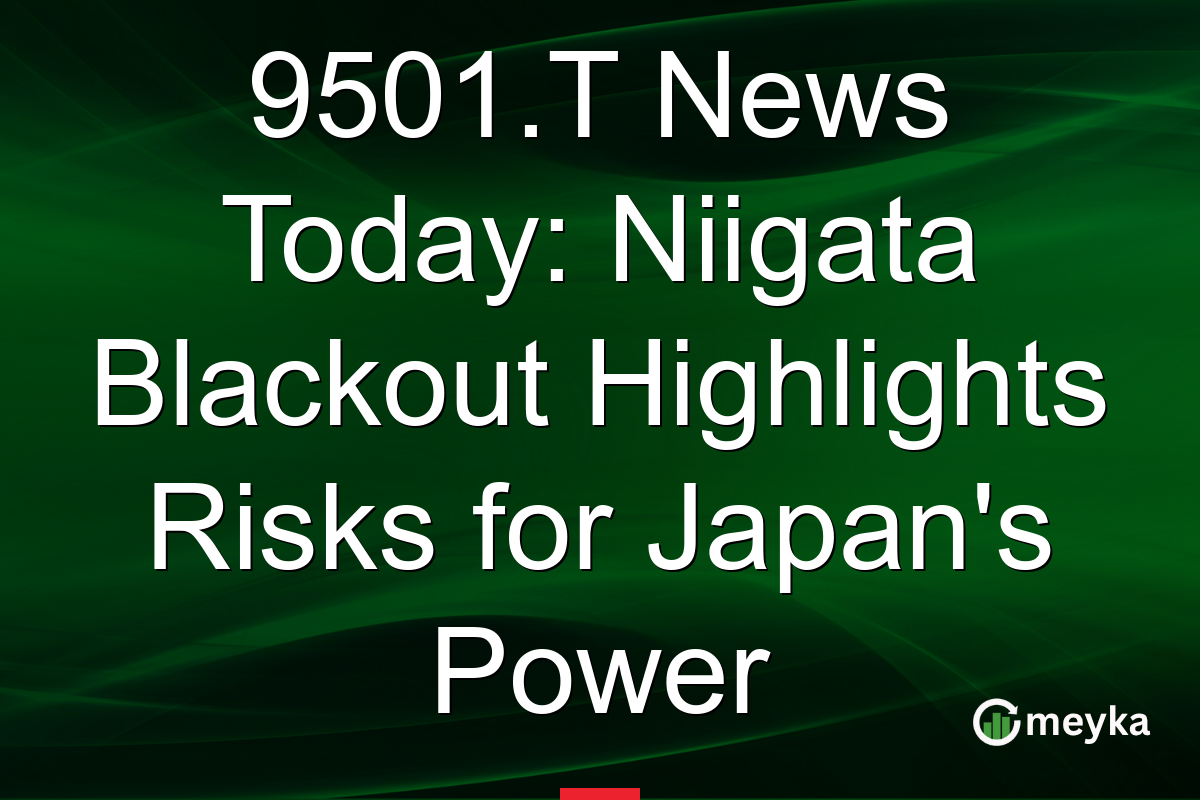9501.T News Today: Niigata Blackout Highlights Risks for Japan’s Power
The recent blackout in Niigata City has cast a spotlight on Japan’s energy vulnerabilities and disrupted thousands of households. This power outage has placed Tokyo Electric Power Company (TEPCO) at the center of scrutiny, given its role as the region’s electricity supplier. As a result, the utility giant’s stock, represented by symbol 9501.T, has drawn significant attention from investors. With the stock experiencing volatility, there is a growing analysis of the operational and reputational impacts of this incident. Investors are keenly evaluating whether this event might signal broader issues within Japan’s energy infrastructure and what it means for future investments.
The Niigata Blackout and Its Immediate Impact
On September 18, Niigata City experienced a major power shortage, leaving numerous residents and businesses in the dark. This disruption affected vital services, raising concerns about the resilience of Japan’s energy systems. According to reports, TEPCO, as the primary utility provider, faced scrutiny over the cause and management of the event. The blackout has brought to light Japan’s growing energy infrastructure risk, particularly as it pertains to aged systems struggling to meet modern demands. While power was eventually restored, the event highlighted the need for urgent infrastructure upgrades. Bloomberg reports indicate a rigorous investigation is underway to uncover the exact causes and prevent future occurrences. This shows the critical need for Japan to invest in more robust and future-proof energy solutions to prevent recurrence.
Investors’ Reaction to the Blackout
Following the Niigata blackout, TEPCO’s stock, trading as 9501.T, saw a notable decline. The stock price dropped by 11.67%, a significant move indicating investor alarm. This market reaction reflects heightened concerns about TEPCO’s ability to manage operational disruptions and maintain service reliability. The market cap stood at ¥1.13 trillion, with the day’s low at ¥651.5 and a high at ¥715.5, showing the stock’s vulnerability to such negative news. Analysts have varied views, with some maintaining a ‘neutral’ rating, while others highlight underlying financial risks. Investors are looking closely at TEPCO’s upcoming earnings announcement due on October 29, which could offer more insights into the company’s strategy to mitigate future risks.
Long-term Implications for Japan’s Energy Infrastructure
The blackout has sparked a debate on Japan’s long-term energy policies and infrastructure investment. Japan relies heavily on a complex grid system and a mix of renewable and non-renewable resources, which must meet the growing demand effectively. The vulnerability shown during this blackout suggests that more scalable solutions are vital for Japan’s energy security. Expanding renewable energy capacity, along with enhancing grid resilience, appears critical for sustaining economic stability and growth. For investors, the focus shifts to companies that prioritize innovation and infrastructure investment, spotlighting potential opportunities within the energy sector for forward-thinking strategies. Reuters highlights these growing needs amid rising climate and energy challenges.
Understanding the TEPCO Stock Impact
TEPCO’s financial metrics further illustrate the broader implications of the blackout event. With a PE ratio of 21.65 and EPS at 32.66, the company appears financially stretched in addressing both operational and reputational risks. In the past six months, the stock has seen a 36.48% decline, worrying investors about potential future earnings impact. The company’s substantial debt ratio, alongside slow infrastructure upgrades, adds to investor anxiety about future profitability and stability. Looking ahead, investors will monitor TEPCO’s response and investment strategies closely, as these will significantly influence the stock’s recovery and performance potential.
Final Thoughts
The Niigata blackout vividly highlights the precarious state of Japan’s energy infrastructure and its potential impact on companies like TEPCO. As the nation grapples with these challenges, investors are tasked with discriminating between immediate setbacks and longer-term opportunities. TEPCO’s stock drop after the blackout underscores the critical relationship between operational reliability and market valuation. For investors, understanding the broader implications of energy risks helps in navigating this sector’s complexities. It also opens pathways to explore diversification and investments in innovative solutions offering greater resilience. As global energy demands rise, a balanced portfolio within the utility sector might provide hedges against such risks. Platforms like Meyka can assist investors by providing real-time insights and predictive analytics, helping navigate this volatile environment more effectively. As we await further developments, monitoring policy changes and infrastructure investments will be crucial for strategic decision-making.
FAQs
The blackout in Niigata was linked to potential infrastructure failures, emphasizing the need for upgrades. An investigation is ongoing to pinpoint the exact cause to prevent future incidents.
TEPCO’s stock experienced a significant drop of 11.67% following the blackout, reflecting investor concerns over operational stability and infrastructure risks.
The blackout suggests urgent upgrades are necessary in Japan’s energy systems to enhance reliability and resilience, with potential implications for investment in the sector.
TEPCO is under scrutiny with an investigation in progress. Details of any strategic changes are expected in their upcoming earnings report on October 29.
Investors should consider the implications of infrastructure risks and diversify within the utility sector, focusing on companies prioritizing innovation and resilience.
Disclaimer:
This is for information only, not financial advice. Always do your research.






